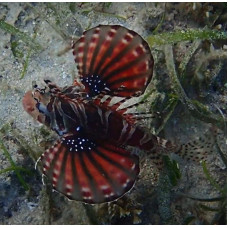Latin name
Pterois volitans
Other names
Red firefish, red turkeyfish, common lionfish, common firefish, common turkeyfish, butterfly cod, scorpion volitans, scorpion cod, zebrafis, peacock lionfish.
Identification
Long, silently oscillating fins and head growths (of which the growth over the eye is particularly developed) make the fish look like a bundle of algae.
Characteristic features of the larvae include a large head, a long triangular face, long serrated spines on the head, a large pelvic spine, and coloration of the pelvic fins only. The larvae hatch 36 hours after fertilization. They swim well and can feed on small infusoria as early as four days after fertilization. The larval stage is the shortest life stage of the wingfish, lasting about a month.
Features of fish fins
The long dorsal and pectoral fins give the fish a bizarre appearance. Like many species in the Scorpaenidae family, they have large venomous spines on the dorsal fin and other venomous spines on the pelvic and anal fins.
Fish colouring
The body coloration of these fish is red with numerous bright stripes.
Distribution
Found in the tropical waters of the Indian and Pacific Oceans - off the coasts of China, Japan and Australia. Recently, it has spread to the coral reefs of the Caribbean coast of the island of Haiti and the Mona Strait.
Habitat
Usually, the fish stands motionless for a whole day in a niche between the corals, and in this position it is hardly noticeable except for very long rays from its widely spread pectoral fins. Fish that have decided to examine this bundle suddenly fall into a wide open mouth. In the evening, the red lionfish come out of hiding and move quietly to a new location.
Size
Maximum body length is 45.7 cm. Juveniles are usually shorter than 2.5 cm. Body weight reaches 1 kg. On average, they live about 10 years.
Behavior
If a Red Lionfish is approached by a creature that is dangerous to it, it will instantly turn poisoned spears of its barbs toward the creature. These fish reproduce monthly and are able to disperse rapidly during the larval stage, expanding their area of invasion.
Food and feeding habits
They are predatory fish. They can easily swallow fish up to two-thirds of their own length.
Reproduction
It is a solitary species, coming together only for courtship, usually one male with several females. They show sexual dimorphism only during breeding. During courtship, circling, dodging, stalking, and leading are observed. After courtship, the female releases two eggs, which are fertilized by the male before surfacing. The embryos secrete a sticky mucus that allows them to attach to nearby intertidal rocks and coral before hatching. Females can lay up to 30,000 eggs in a single mating. It has been observed that females lay more eggs during the warmer months of the year.
Fishing
Is the object of commercial underwater hunting, the taste of meat at the red lionfish on the fan.
Relationship with a person
A sting from the barbs of this fish is very painful. The venom causes convulsions and paralysis. Necrosis or sepsis occurs at the bite site. Injection often results in loss of consciousness.
Red lionfish poses a threat to the ecosystem of the Caribbean Sea, destroying many species of coral fish.
This species is kept in aquariums.
| Classification | |
| Phylum | Chordata |
| Class | Actinopterygii |
| Squad | Scorpaeniformes |
| Family | Scorpaenidae |
| Genus | Pterois |
| Species | P. volitans |
| Features | |
| Conservation status | Least Concern |
| Habitat | Pelagic |
| Life span, years | 10 |
| Maximum body weight, kg | 1 |
| Maximum length, cm | 45,7 |
| Sailing speed, m/s | No information |
| Threat to people | Not edible |
| Way of eating | Predator |
Red lionfish
Tags: red lionfish



